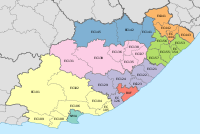Baviaans Local Municipality elections
The council of the Baviaans Local Municipality was elected in 2000, 2006 and 2011. The first two elections were conducted by a system of party-list proportional representation, while the 2011 election used mixed-member proportional representation. In 2016 the Baviaans Local Municipality was merged with two others to create the Dr Beyers Naudé Local Municipality; for election results in the merged municipality see Dr Beyers Naudé Local Municipality elections.
Results
[edit]The following table shows the composition of the council after past elections.
| Event | ANC | DA | Other | Total |
|---|---|---|---|---|
| 2000 election | 2 | 3 | 0 | 5 |
| 2002 floor-crossing | 4 | 1 | 0 | 5 |
| 2006 election | 2 | 3 | 0 | 5 |
| 2011 election | 3 | 4 | — | 7 |
2000 elections
[edit]The Baviaans Local Municipality was created in 2000, replacing the transitional local councils of Willowmore and Steytlerville. The council consisted of five members; the Democratic Alliance (DA) obtained a majority of three.
| Party | Votes | % | Seats | |
|---|---|---|---|---|
| Democratic Alliance | 2,234 | 50.68 | 3 | |
| African National Congress | 2,063 | 46.80 | 2 | |
| United Democratic Movement | 111 | 2.52 | 0 | |
| Total | 4,408 | 100.00 | 5 | |
| Valid votes | 4,408 | 98.31 | ||
| Invalid/blank votes | 76 | 1.69 | ||
| Total votes | 4,484 | 100.00 | ||
| Registered voters/turnout | 6,436 | 69.67 | ||
| Source: [1] | ||||
October 2002 floor crossing
[edit]In terms of the Eighth Amendment of the Constitution and the judgment of the Constitutional Court in United Democratic Movement v President of the Republic of South Africa and Others, in the period from 8–22 October 2002 councillors had the opportunity to cross the floor to a different political party without losing their seats. In the Baviaans council, two councillors crossed from the DA to the African National Congress (ANC), giving the ANC a majority of four.[2]
| Party | Seats before | Net change | Seats after | |
|---|---|---|---|---|
| African National Congress | 2 | 4 | ||
| Democratic Alliance | 3 | 1 | ||
2006 elections
[edit]The DA obtained a majority of three out of the five members.
| Party | Votes | % | Seats | |
|---|---|---|---|---|
| Democratic Alliance | 2,170 | 47.31 | 3 | |
| African National Congress | 2,136 | 46.57 | 2 | |
| Independent Democrats | 281 | 6.13 | 0 | |
| Total | 4,587 | 100.00 | 5 | |
| Valid votes | 4,587 | 98.90 | ||
| Invalid/blank votes | 51 | 1.10 | ||
| Total votes | 4,638 | 100.00 | ||
| Registered voters/turnout | 7,572 | 61.25 | ||
| Source: [3] | ||||
2011 elections
[edit]At the time of this election the council was expanded to seven members, and the municipality was demarcated into four wards. Four councillors were elected by first-past-the-post voting from the wards, while the other three were appointed from party lists so that the total number of party representatives was proportional to the number of votes received. The DA obtained a majority of four members.
| Party | Ward | List | Total seats | |||||
|---|---|---|---|---|---|---|---|---|
| Votes | % | Seats | Votes | % | Seats | |||
| Democratic Alliance | 3,644 | 55.50 | 3 | 3,629 | 55.24 | 1 | 4 | |
| African National Congress | 2,922 | 44.50 | 1 | 2,940 | 44.76 | 2 | 3 | |
| Total | 6,566 | 100.00 | 4 | 6,569 | 100.00 | 3 | 7 | |
| Valid votes | 6,566 | 98.75 | 6,569 | 98.71 | ||||
| Invalid/blank votes | 83 | 1.25 | 86 | 1.29 | ||||
| Total votes | 6,649 | 100.00 | 6,655 | 100.00 | ||||
| Registered voters/turnout | 9,321 | 71.33 | 9,321 | 71.40 | ||||
| Source: [4] | ||||||||
References
[edit]- ^ "Election Result Table for LGE2000 — Baviaans". wikitable.frith.dev. Retrieved 24 December 2021.
- ^ "2002 Detailed Floor Crossing Report" (PDF). Electoral Commission. Retrieved 25 August 2016.
- ^ "Election Result Table for LGE2006 — Baviaans". wikitable.frith.dev. Retrieved 24 December 2021.
- ^ "Election Result Table for LGE2011 — Baviaans". wikitable.frith.dev. Retrieved 24 December 2021.

